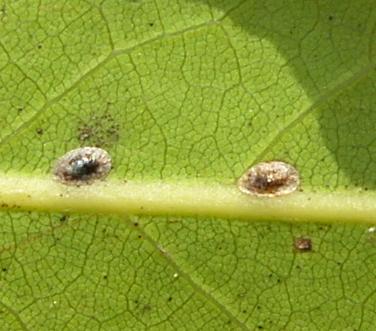 Mature Soft Brown Scale Insects |
Soft Brown Scale Insects are a bit like minature turtles in shape and are about 2 to 4mm long. The older females are dark brown and are usually found along the centre vein on the under side of a leaf where they suck the sap. They excrete 'honeydew' which is full of sugars and drops onto the lower leaves or anything below - this attracts other insects such as ants and wasps to feed on it, or Sooty Mould grows on it causing further damage as it blocks out light. Also you may find nymphs, known as crawlers as they are able to move around, the older females loose their mobility and eventually die, but their shell remains to protect the eggs.
Reproduction can be sexual or asexual (parthenogenesis) - every female may be capable of producing progeny without fertilization. The eggs hatch into first stage nymphs, or crawlers, when they are laid. These move out to find feeding sites within a few days. After about a week, they molt into the second stage, a passive nymph. Adult males and females emerge in about a month. The males have wings and are rarely seen. There can be up to six or seven generations a year indoors, so a colony can rapidly grow.
They attack vines, currants, cotoneasters and seem to prefer citrus and bay trees. The leaves become yellow and the shrub fails to thrive. A growth of Sooty Mould is usually the indication that the little beasts are present. The upper surface of the leaves become blackened by the mould which is living on the honeydew that the scale insects have excreted,particularly in drier weather as rain washed off most of the fallen honeydew.
You can remove the scales if the plant is not too big, just use your fingernail or a toothbrush to scrape them off on tough leaves like bay. This will probably have to be repeated a few times, but you should win in the end if you persist.
They have a waxy cuticle so contact insecticides have little effect, the best type to use is a systemic insecticide like Provado, these are taken up by the plant so as the insects feed they consume the poison. The best time to attack them is at the pale brown juvenile stage when they have not yet developed their waxy coat fully.
Immature scale and crawlers - the stages more susceptible to insecticides.
Back to GARDEN CREATURES